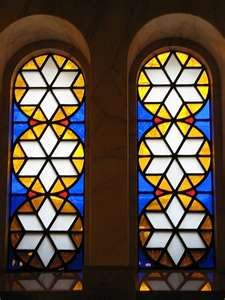Last week we discussed the various reasons given for the custom to have windows in a shul. Among the sources mentioned was a passage in the Zohar (Pekudei II:251a) which is brought down in the Beit Yosef (OC 90). The passage is based on a verse from Shir HaShirim: “Behold, one stands behind our wall, gazing through the windows, peeping through the lattice” (Shir HaShirim 2:9). These two kinds of vision represent two different levels of Divine Providence. As explained by Rabbi Yechiel Bar Lev, “peeping through the lattice” is a narrow level of supervision that reveals specifically our acts; “gazing through the window” is a broader level that encompasses also our prayers. These are complementary; at times our deeds are judged favorably because they are viewed in the broader context of our desires and our turning towards Hashem; at other times our prayers may be accepted (or GF turned aside) because of the worth of our acts.
Compared to the other commentaries we discussed, the Zohar’s explanation of the need for a window is unique in two ways: First, as we mentioned last week: the window is not one through which we see (the outside world, the light, or Jerusalem) but rather one through which we are seen.
Second, there is special significance to the fact that all prayers go through the same window. “These windows and these lattices all stand to unify all the prayers that rise from beneath to the above, and to supervise them to bring them in before the Holy One, blessed be He.” This is why windows are important particularly in a shul. They serve to unite and thus augment the individual prayers of the congregants. (This is the opposite of the ruling of the Rambam in a responsum in which he says that windows are necessary only in a house, but not in a shul. The basis for Rambam’s ruling is the original source for the rule, which is the private prayer of Daniel, and the language of the gemara which refers specifically to a house. See Kesef Mishnah Tefillah 5:6.)
The Shulchan Arukh (OC 90:4) further states that ideally we should have 12 windows in Beit Knesset. The source is the same passage in the Zohar. Based on the commentaries, the significance of having many windows is that our acts are observed from many angles. (Indeed, the Ateret Zekinim writes that we should strive to have windows on all four walls, to emphasize the idea that we are observed from all sides.) Each one observes and concentrates one specific kind of good deed or thought. From one side we observe a person’s acts of kindness; from another we may see his Torah study, and so on.
Thus, having many windows in a shul is both a consolation and a challenge. On the one hand it is a consolation; even if a person excels in only one aspect of Torah observance, he can be sure that these good deeds are noticed on high, and help his (or her) prayers to be accepted. On the other hand it is a challenge: even if a person excels in one area, he remembers that he is being viewed from many other angles as well, and is thus stirred to improvement in all areas of upright conduct.
Another explanation I have often heard is that the twelve windows correspond to the twelve tribes, meaning that there are many different kinds of Jews. This explanation fits in particularly well with the idea of the window as uniting and concentrating the prayers of many individuals. Different people have different natures and inclinations; each type has their own window, and finds an opening to heaven which specifically suits their approach to serving God.
Rabbi Asher Meir is the author of the book Meaning in Mitzvot, distributed by Feldheim. The book provides insights into the inner meaning of our daily practices, following the order of the 221 chapters of the Kitzur Shulchan Arukh.
The words of this author reflect his/her own opinions and do not necessarily represent the official position of the Orthodox Union.
